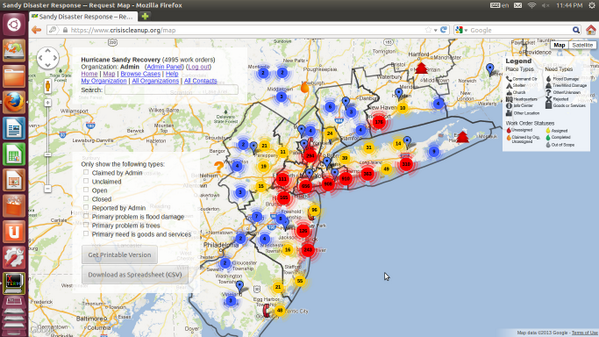When everything falls apart, it can be nearly impossible to effectively allocate a surge in volunteer resources. Given the way nonprofits and NGOs vie for resources and prioritize missions, a third party information sharing system can be so helpful in just those times.
Andy Gimma, a Bed-Stuy resident and one of the core members of the team behind CrisisCleanup.org, spoke at the recent Brooklyn Internets meetup, about the origin of the “collaborative crisis incident work-order tracking system” that he and his colleagues developed.
He explained that it arose largely out of Superstorm Sandy, as a way for organizations to log particular sites that needed help, what they needed and which organization would claim responsibility for meeting those needs. As a volunteer on the ground, Gimma realized that there was a need for better coordination.
Gimma explained that, during Sandy cleanup efforts, he saw streets where one side of a block would get canvassed multiple times and the other side wouldn’t be canvassed at all. It helps volunteers to know where others have been, to help them reach those who haven’t been reached yet. One of Gimma’s cofounders had similar experiences in previous cleanup efforts, and had begun experimenting with digital tools before meeting Gimma during the Sandy efforts.
In an email to Technically Brooklyn, Gimma noted its bootstrapping style: “We went about seven months between grants and kept working on it because we felt it was useful and important, so there is a lot of trust on our team. It’s great to work with people who are doing this for the right reasons. I’m excited to work on this project every day.”
The site has had over 500 revisions since it launched. Gimma said the team is working to model both near-term and long-term recovery.
“For instance, removing trees happens early after a hurricane, but there are steps to follow to get to a fully restored home. Our new software will help model those steps. It will also help organizations track these steps, and make data tracking easier.”
In other recent updates, the site allowed organizations to access the site by using an older login from a previous incident, it began caching reports to dramatically speedup downloads and a stats service to let organizations see broad statistics across a whole disaster area.
The project has received many awards and certifications. The site has since been used at many other incidents, including the recent Colorado flooding. The project is open source and a project of the NJ 2-1-1 Partnership.
The team has also recently launched a project to help non-technologists take part in assisting in worldwide humanitarian relief. It’s called the Digital Humanitarian Training. It has a Meetup coming up soon in Queens.
Before you go...
To keep our site paywall-free, we’re launching a campaign to raise $25,000 by the end of the year. We believe information about entrepreneurs and tech should be accessible to everyone and your support helps make that happen, because journalism costs money.
Can we count on you? Your contribution to the Technical.ly Journalism Fund is tax-deductible.
Join our growing Slack community
Join 5,000 tech professionals and entrepreneurs in our community Slack today!
